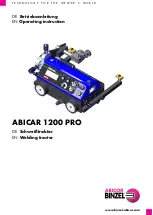
0430-INS-400 Rev. D
3- 1
Tolerancing and Monitoring
Introduction
This chapter will introduce Livingston's concept of dynamic resistance weld monitoring. The
definitions of
tolerances
and
segments
as they pertain to a WeldWise™ 2400 will be discussed, as well
as how these features allow the user to immediately identify and correct faulty parameters or
conditions that can produce poor quality welds. Different parameters that can be monitored using
Livingston equipment will be identified, in addition to some of the ways that monitoring can be used to
simplify and refine the weld process.
Livingston WeldWise™ Monitor
The WeldWise
™
2400 Dynamic Resistance Weld Monitor is a portable bench top unit that, when
connected to the appropriate sensors, can be used to monitor a single weld head in a fixed location or
rotated on your factory floor to monitor different weld heads, one at a time. If a weld is not within
master tolerance limits, the WeldWise 2400
™
sends a
reject
signal to a PLC or similar controller,
which is then displayed on the monitor as a 'rejected' weld. If the weld is within tolerances, the
WeldWise 2400
™
sends an
accept
signal, which is displayed as an 'accepted' weld.
The WeldWise
™
2400 performs real-time monitoring on a halfcycle-by-halfcycle basis for AC welds.
A 'halfcycle' is exactly what the name implies: one half of a weld cycle, based on a 50 or 60 Hz sine
wave.
Signatures and Masters
Once a Livingston weld monitor and sensors have been installed and the WMS (Weld Monitoring
Software) program is running, the monitor continually collects data from the sensors. When a weld is
made, information about that weld is captured, analyzed, displayed and stored by the monitor. This
information is called a
weld signature
. Simply put, a weld signature is the distinct characteristics of
any particular weld. From either one or a collection of high-quality weld signatures, a
master signature
is made. Throughout this text, a
master signature
and its related tolerances (see below) will be referred
to simply as a
master
. A 'high-quality' weld signature is the signature of any production weld made that
was proven to be high quality through destructive testing. A
master
is a set of values representing those
conditions that make for a high-quality weld.
A master is created in the WMS program by making a high-quality production weld and using its
corresponding signature. The master is what defines the acceptable range for individual weld
parameters through
tolerances
, which are initially drawn from a set of default values installed when the
master is made. Once a master is created, tolerances can be individually modified by the user and
depending on the application, can be loosely or strictly defined. Once tolerances are defined for a
master, every subsequent weld made will be compared with the stored
master tolerance limits
. If the
weld does not fall within the
master tolerance limits
of that master, the monitor will record a r
eject
signal and display it as a rejected weld. Using a PLC, this signal can also be set to trigger a variety of
rejected-weld responses, such as lights, buzzers, and reset-reliant restrictions (the electrodes will
Summary of Contents for WELDWISE 2400
Page 1: ...Revision C 001 User s Manual WeldWise 2400 THE WELD MONITORING SPECIALISTS TM...
Page 2: ......
Page 34: ...4 6...
Page 46: ...5 12...
Page 94: ...6 48...
Page 104: ...7 10...
Page 116: ...9 4...
Page 146: ...10 30...
Page 164: ...0340 DWG 400 Rev C 11 18...
Page 165: ...0308 DWG 400 Rev D 11 19...
Page 168: ...11 22...
Page 176: ...0454 APP 118 Rev A 12 6...
Page 194: ...13 2...
















































